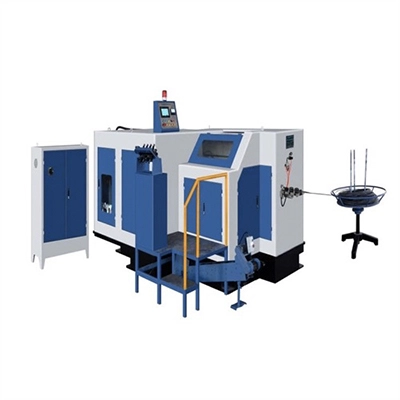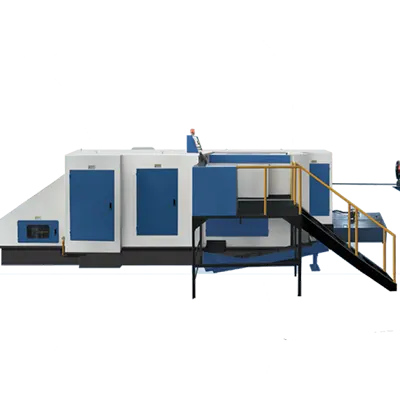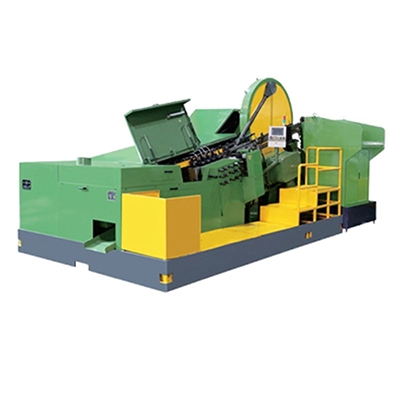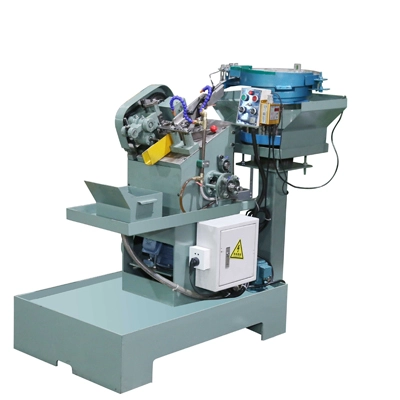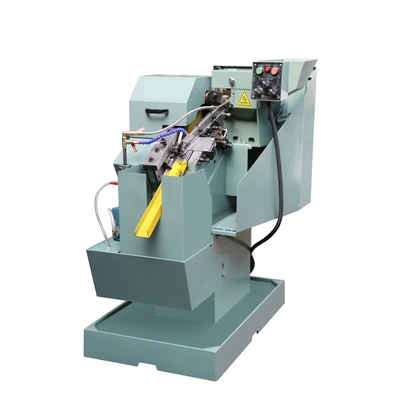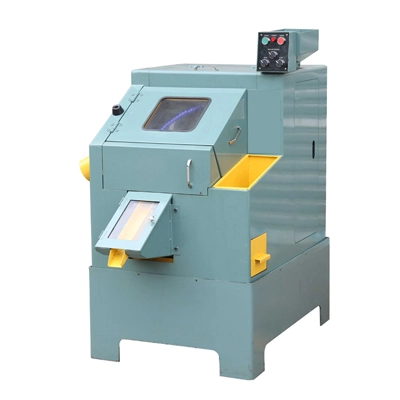A forging method of thickening the top of a bar or wire at room temperature. Cold heading is mainly used to manufacture parts such as bolts, nuts, nails, rivets and steel balls. The forging material can be copper, aluminum, carbon steel, alloy steel, stainless steel and titanium alloy, etc. The material utilization rate can reach 80~90%. Cold heading is mostly carried out on a dedicated cold heading machine, which facilitates continuous, multi-station, and automated production. Cutting, heading, accumulation, forming, chamfering, thread rolling, diameter reduction and trimming can be completed in sequence on the cold heading machine. The production efficiency is high, up to 300 pieces/min or more, and the diameter of the largest cold heading workpiece is 48 mm. Figure 1 Schematic diagram of cold heading bolt process is a typical process of cold heading bolts. Figure 2 Multi-station nut automatic cold heading machine is a multi-station nut automatic cold heading machine. The bar material is automatically fed to a certain length by the feeding mechanism, and the cutting mechanism cuts it into blanks, and then is sequentially sent to the accumulation pressing and punching stations by the clamp transmission mechanism for forming.
In the cold heading method, the cold heading machine can be divided into two types: mechanical transmission and hydraulic transmission according to different ways of power transmission. There are two types of mechanical transmission: manual and electric, electric and manual cold heading machines, suitable for cold heading low carbon steel wire with a diameter of 4 to 5 mm. According to its performance, hydraulic transmission can be divided into two types: hydraulic steel wire cold heading machine and hydraulic steel cold heading machine.
Manual cold heading machine is a steel heading machine + structure that uses manpower as the driving force to press the steel bar head into the required shape.
The working principle of the manual cold heading machine is: pull the handle 6 to move the upper and lower clamping blocks of the clamp 1 back. Since the clamping block and the cone sleeve are in contact with the cone, the upper and lower blocks of the clamp 1 are separated under the action of the taper. At the same time, send the steel wire 7 to the clamp port, and reach the upsetting die 2, relax the handle 6, and under the action of the spring 3, the steel wire 7 is automatically clamped. At this time, pull the eccentric wheel wrench 5 to drive the eccentric wheel 4 to rotate, forcing the upsetting die 2 to move forward to complete the upsetting of the wire end. Then return the eccentric block 4 to its original position, reset the upsetting die 2 by the pressure spring 3, pull the handle 6 to separate the clamp 1, and take out the upset steel wire. The manual cold heading machine is simple in structure, convenient to use, and not limited by the power supply, but it is only suitable for cold heading low carbon steel wire with small diameter (φ 4~5mm).
Key points of using manual cold heading machine:
(1) The diameter of the steel bar or steel wire should meet the requirements of the cold heading machine, and the steel bar (wire) that is too thick or too thin should not be cold-headed;
(2) Within the allowable range of the cold heading diameter of the punching machine, the position of the clamp (screw in or out) can be adjusted according to the required anchoring head size to obtain a suitable rebar (wire) extension;
(3) Derusting and straightening are required in the area of 120~130mm of the cold heading part of the steel bar (wire);
(4) The ends of the steel bars should be ground flat to ensure the accurate shape of the cold heading anchor;
(5) After the steel bar is headed, it must undergo a tensile test to check whether the strength of the anchoring head is qualified.
 Thread Cold Rolling Machine
ST-4R-50 High-Speed Thread Rolling Machine ST-8R-83(120) High-Speed Thread Rolling Machine ST-6R-80 High-Speed Thread Rolling Machine ST-4A-50 High-Speed Thread Rolling Machine ST-4A-25 High-Speed Thread Rolling Machine ST-10N-150 High-Speed Thread Rolling Machine ST-30N High-Speed Thread Rolling Machine ST-60N(M16-150) High-Speed Thread Rolling Machine ST-60N(M16-200) High-Speed Thread Rolling Machine ST-12N-150 High-Speed Thread Rolling Machine ST-3A-25 High-Speed Thread Rolling Machine ST-3 High-Speed Thread Rolling Machine ST-80N High-Speed Thread Rolling Machine ST-90S High-Speed Thread Rolling Machine ST-100-M40 High-Speed Thread Rolling Machine ST-70N End Milling Machine
Thread Cold Rolling Machine
ST-4R-50 High-Speed Thread Rolling Machine ST-8R-83(120) High-Speed Thread Rolling Machine ST-6R-80 High-Speed Thread Rolling Machine ST-4A-50 High-Speed Thread Rolling Machine ST-4A-25 High-Speed Thread Rolling Machine ST-10N-150 High-Speed Thread Rolling Machine ST-30N High-Speed Thread Rolling Machine ST-60N(M16-150) High-Speed Thread Rolling Machine ST-60N(M16-200) High-Speed Thread Rolling Machine ST-12N-150 High-Speed Thread Rolling Machine ST-3A-25 High-Speed Thread Rolling Machine ST-3 High-Speed Thread Rolling Machine ST-80N High-Speed Thread Rolling Machine ST-90S High-Speed Thread Rolling Machine ST-100-M40 High-Speed Thread Rolling Machine ST-70N End Milling Machine English
English 中文
中文
